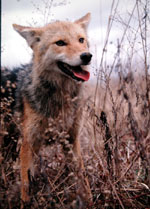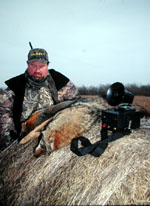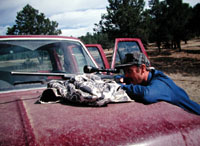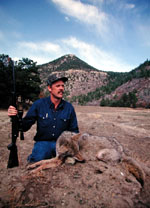
|
Features
|
|
|
|
Books
|
|
|
|
Fun & Games
|
|
|
|
Contact Us
|
|
|
John's Journal... Entry 143, Day 1
SUNTANS AND COYOTES
Brad Harris On Taking Coyotes
 EDITOR'S
NOTE: If you hunt coyotes at this time of year, not only will you
get a suntan instead of frostbite, but the tactics you use will change.
Because you'll deal with older animals, you can use territorial calls
and pup calls along with distress calls. Here's what three of the nation's
leading coyote hunters say about the techniques they use to take the song
dogs during the long, hot days of summer.
EDITOR'S
NOTE: If you hunt coyotes at this time of year, not only will you
get a suntan instead of frostbite, but the tactics you use will change.
Because you'll deal with older animals, you can use territorial calls
and pup calls along with distress calls. Here's what three of the nation's
leading coyote hunters say about the techniques they use to take the song
dogs during the long, hot days of summer.
The director of public relations for Lohman's Manufacturing, a division of Outland Sports, in Neosho, Missouri, Brad Harris has called and hunted coyotes for many years. According to Harris, "One big difference between summer and winter coyote hunting is the amount of foliage on the trees and bushes. Lush foliage hampers long-distance visibility and limits your calling range. During the hot summer months, coyotes are less active in the daylight hours than in winter when the weather's cooler. Hunting just before daylight and just before dark will be your most productive times."
 Because
of the older ages of the dogs of summer, they've learned more about how
to dodge hunters than the younger dogs of fall and winter have. You'll
find camouflage much more important in the summer for success, and the
calls you use may vary. "I look for open areas where I can see long distances,"
Harris explained. "Fresh-cut hayfields, power-line right-of-ways or areas
that have been recently bushhogged or clear-cut are prime coyote hunting
places as is a flood plain where the water's been backed up for an extended
period and killed the foliage beneath the trees. Then you can see much
further. Regardless of how well you call, if you can't see the coyotes,
you can't take them."
Because
of the older ages of the dogs of summer, they've learned more about how
to dodge hunters than the younger dogs of fall and winter have. You'll
find camouflage much more important in the summer for success, and the
calls you use may vary. "I look for open areas where I can see long distances,"
Harris explained. "Fresh-cut hayfields, power-line right-of-ways or areas
that have been recently bushhogged or clear-cut are prime coyote hunting
places as is a flood plain where the water's been backed up for an extended
period and killed the foliage beneath the trees. Then you can see much
further. Regardless of how well you call, if you can't see the coyotes,
you can't take them."
 Harris
likes to hunt from the deer stands he's used in the winter. Coyotes expect
their food and danger to come from the ground. They probably won't spot
you as easily when you move, if you hunt from a tree stand. "When you
get up off the ground in a tree stand, your calls generally will carry
further, and you can work the coyotes in much closer than when you work
from the ground," Harris reported. He learned how to hunt coyotes from
a tree stand while bowhunting in the fall. He called to coyotes he spotted,
and noticed that usually they walked right up under his tree stand and
never spooked. After deer season, he continued to hunt coyotes from a
tree stand and found this a deadly-effective technique during the summer
months.
Harris
likes to hunt from the deer stands he's used in the winter. Coyotes expect
their food and danger to come from the ground. They probably won't spot
you as easily when you move, if you hunt from a tree stand. "When you
get up off the ground in a tree stand, your calls generally will carry
further, and you can work the coyotes in much closer than when you work
from the ground," Harris reported. He learned how to hunt coyotes from
a tree stand while bowhunting in the fall. He called to coyotes he spotted,
and noticed that usually they walked right up under his tree stand and
never spooked. After deer season, he continued to hunt coyotes from a
tree stand and found this a deadly-effective technique during the summer
months.
 "I
like to have eight to 10 tree stands set up in the woods in areas where
I want to call coyotes," Harris commented. "Then I can go to those stands
and call for 10 to 20 minutes. If a coyote shows up, I can take it. Or,
if I don't see any animals in that length of time, I can move to another
stand. With this tactic, I can hunt many places in one day and drastically
increase my odds for taking coyotes."
"I
like to have eight to 10 tree stands set up in the woods in areas where
I want to call coyotes," Harris commented. "Then I can go to those stands
and call for 10 to 20 minutes. If a coyote shows up, I can take it. Or,
if I don't see any animals in that length of time, I can move to another
stand. With this tactic, I can hunt many places in one day and drastically
increase my odds for taking coyotes."
When Harris hunts coyotes from a tree stand, he prefers to use a bulb-type mouse squeaker, a chipmunk call or birds-in-distress sounds. He considers subtle calling much more effective than loud, long-range calling. "Anytime I'm hunting in the timber as opposed to fields, I rely more on my soft calling than I do on loud calling," Harris explained.
TOMORROW: BRAD HARRIS ON SCENT CONTROL
Check back each day this week for more SUNTANS AND COYOTES...
Day 1 - Brad Harris On Taking
Coyotes
Day 2 - Brad Harris On Scent Control
Day 3 - Brad Harris On Coyote Calling When
You Don't Know How And Decoys
Day 4 - David Hale On Coyote Calling
Day 5 - Ken Allein On Coyote Calling